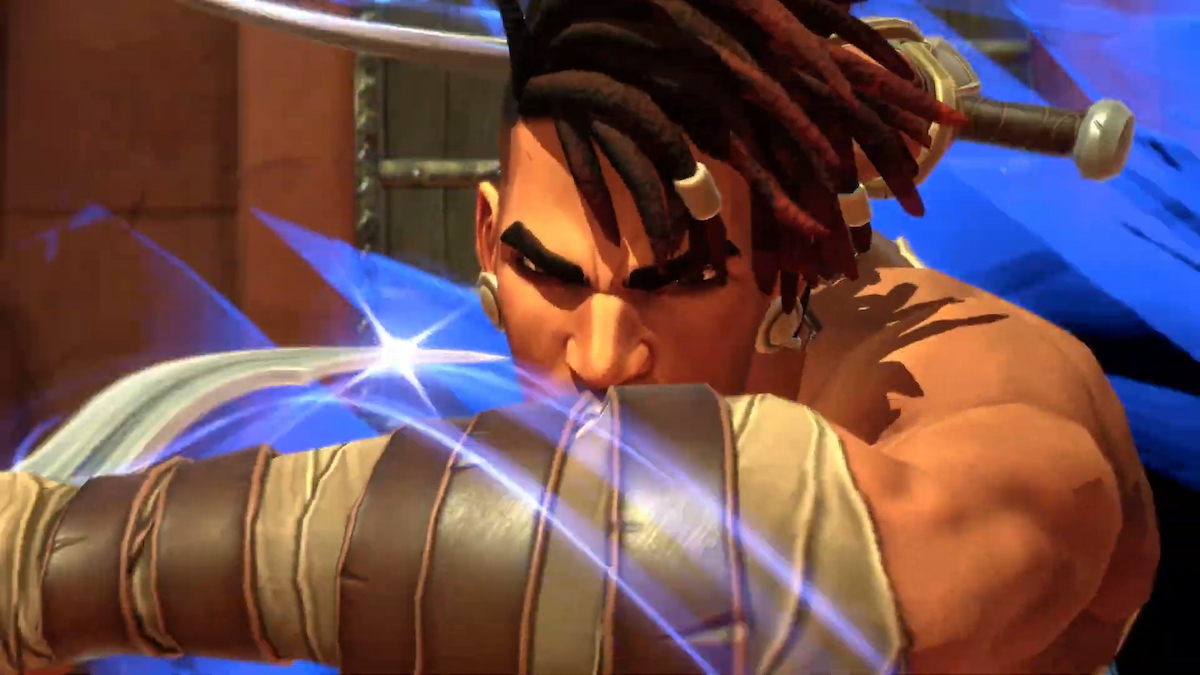Deadpool
Games That Break the Fourth Wall

When you think of the character you think of two things: Ryan Reynolds and breaking the fourth wall. Well, Deadpool was taking a sledge hammer to the fourth wall long before Reynolds donned the red and black leather, most notably in his own video game. Every kind of fourth wall demolition imaginable is in this game.
Deadpool threatening the devs at High Moon Studios to create the game and ignoring them every time they complain about the game’s budget? Check. The voices in Deadpool’s head holding conversations with each other and directly talking to the audience? Also check. Button prompts including hilarious descriptions that make fun of themselves? Check and check. A fakeout ending? Wouldn’t be Deadpool without one. Half the fun of the game is seeing how many ways High Moon Studios can blow up the fourth wall, rebuild it, and blow it up again with more explosives.
Metal Gear Solid Series
Games That Break the Fourth Wall

Hideo Kojima knows how to make a mind screw of a fourth wall break. Almost every game in the Metal Gear franchise annihilates the fourth wall at least once in memorable fashion. The first Metal Gear Solid includes Psycho Mantis, a boss who reads the player’s PlayStation/GameCube memory card and can only be defeated by plugging the controller into the Player 2 slot (he returns in MGS4 in a cute little callback cameo).
MGS2 has the insane codec conversations with “Colonel Roy Campbell;” MGS3 features the infamous Time Paradox game over screen, and the list goes on. These fourth wall breaks insert some much-needed levity in games that teach gamers that war is hell. And that nanomachines might as well be magic.
Batman: Arkham Asylum
Games That Break the Fourth Wall

Batman has faced plenty of villains who try to screw with his mind, but how many of these rogues go after the sanity of the people watching his escapades? Scarecrow is perhaps the only villain who has tried this tactic. Batman: Arkham Asylum follows the rule of three and has Batman face off against Dr. Crane three times.
The first two times aren’t worth talking about too much, but the third fight starts with an intentional visual glitch that simulates the death throes of a graphics card. And then it replays the beginning of the game, except now The Joker drives Batman to Arkham.
Additionally, the game tells players they need to use the middle analog stick to dodge a bullet; I bet half the players who went into this blind stared at their controllers in confusion, trying to find something that doesn’t exist. I hope whoever came up with this sequence got a raise; he or she deserves it.
X-Men (1993 for the Sega Genesis)
Games That Break the Fourth Wall

The 1993 X-Men game for the Sega Genesis isn’t good, but it contains one level that involves some serious metagaming. The game takes place in the X-Men’s holographic Danger Room, and to finish the second-to-final level, players need to “reset the computer.”
Normally, that would mean players have to find a computer in the level and interact with it, but instead, the game implies the Sega Genesis is the computer, which means gamers need to press the reset button to complete the level. Remember when game consoles actually had a reset button? This one moment almost redeems the rest of the game’s mediocrity. Almost.
The Animal Crossing Franchise
Games That Break the Fourth Wall

Nintendo struck gold with its series of life simulation games known as the Animal Crossing franchise. In each game, players meet a cast of memorable characters and can either help them or piss them off, and none is easier to piss off than Mr. Resetti.
This mole’s reason for being is to badger the player (pun intended) whenever he or she doesn’t save before quitting. It doesn’t matter if the player simply forgot or intentionally pushed the reset button, because Mr. Resetti does not forgive and does not forget. Mr. Resetti is one big middle finger to the fourth wall and is strangely fitting for a life simulator, because you can’t reset real life.
Bravely Second: End Layer
Games That Break the Fourth Wall

Spoiler alert: if you haven’t finished Bravely Second and intend to play, skip this page. This is your warning.
Anyway, most of Bravely Second is what we’ve come to expect from Square Enix JRPGs story-wise. But, the final boss, Providence, flat out tells the protagonists they are controlled by a foreign entity that lives in a different dimension (i.e., the player) and claims the player is not only responsible for all the suffering they have endured, but relishes it. And, as any good character aware of the fourth wall, Providence also talks directly to the player and tries to delete the game’s save files. But, Providence is thwarted by one of the protagonists when he physically takes an “S” and a “P” from the game’s title (which has mysteriously been transformed into Bravely Second: Send Player) to obtain “SP” and gain a fighting chance against Providence.
Borderlands
Games That Break the Fourth Wall

The first Borderlands game is a solid open world FPS with Diablo-esque loot mechanics and 17.75 million weapons, but the base game lacks the humor that is now synonymous with the franchise. However, the DLC gives players a taste of the humor that smothers subsequent installments. Enter Dr. Ned, the final boss of The Zombie Island of Dr. Ned. Players who fight him are treated to a quick and anti-climactic shootout that ends in a credit sequence that is literally torn down by the second phase of the fight. There’s a figurative fourth wall break, and then there’s a literal fourth wall break.
Undertale
Games That Break the Fourth Wall

While most fourth wall breaks are little more than glorified Easter Eggs that aren’t exactly hidden, Undertale turns save files, a core game mechanic of video games since 1986, into one ginormous fourth wall break. In the game, saving and loading save files is essentially time traveling that lets players undo past mistakes (or cause them), and several characters remember these mistakes.
If you, say, accidentally kill the first boss of the game and reload a previous save to try again, even if you win without killing her, the characters will make sure to let you know they know you once killed that boss. And that’s just one example…the less I talk about a final boss who uses save slots against the player and one special character I dare not mention, the better. Unlike other games, Undertale lets gamers discover on their own just what is and isn’t a fourth wall break, and some players will be surprised how thin a line separates the two.
Doki Doki Literature Club
Games That Break the Fourth Wall

Spoiler alert: if you haven’t experienced Doki Doki Literature Club and intend to play, skip this page. This is your warning.
OK, let’s go.
Doki Doki Literature Club is less a game with a fourth wall break and more a fourth wall demolition disguised as a game. The character Monika is essentially a sentient computer virus who actively screws around with the game’s files. Sometimes she changes the files, sometimes she deletes them. If players try to copy save files, Monika chastises him or her Mr. Resetti style. And gamers who record the game with XSplit or OBS will be in for a rude awakening when Monika jump-scares them. After she datamines the computer to find the player’s real name. And that’s just the stuff that is guaranteed to happen (with Monika, at least; each character features her own terrifying fourth wall annihilation). Doki Doki Literature Club is full of fourth wall breaks and I would not be surprised if the game is still hiding a few secrets that turn the fourth wall into Swiss cheese.
Eternal Darkness: Sanity’s Requiem
Games That Break the Fourth Wall

And here we are: the king of the fourth wall break. Eternal Darkness: Sanity’s Requiem starts out like any Lovecraft-inspired story. Characters slowly discover dark, eldritch secrets that, as the title suggests, challenge their sanity. As protagonists witness horrific events, usually in the form of monsters that defy every known law of nature and physics, they lose their sanity, and the more sanity they lose, the more likely they will experience hallucinations. And that is where the game breaks the fourth wall.
Some hallucinations are what you would expect from a survival horror game, such as skewed camera angles and blood dripping from the ceiling, but the most memorable hallucinations target the player. The game might suddenly mute itself, pretend to delete save files, or worst of all, flash a fake blue screen of death or end the game abruptly and tease a sequel that will never come. This is why gamers and critics alike praise Eternal Darkness: Sanity’s Requiem; it expertly uses fourth wall breaks to make players feel they’re losing the minds.





Published: Apr 2, 2018 10:00 am